1. Bass reproduction - www.hifilounge.eu
Main menu:
- Home
- General
-
Speakers
- Basics
- Speakers
- Headphones
- Subwoofer
- Elektronics
- Surround
- Photography
- Infos
1. Bass reproduction
Speakers > Subwoofer
The generation of deep and clean bass is one of the biggest challenges for a hifi system - and even more so for the acoustics. Whether the woofer is an integral part of the front speakers or in a separate subwoofer - the problems remain the same.
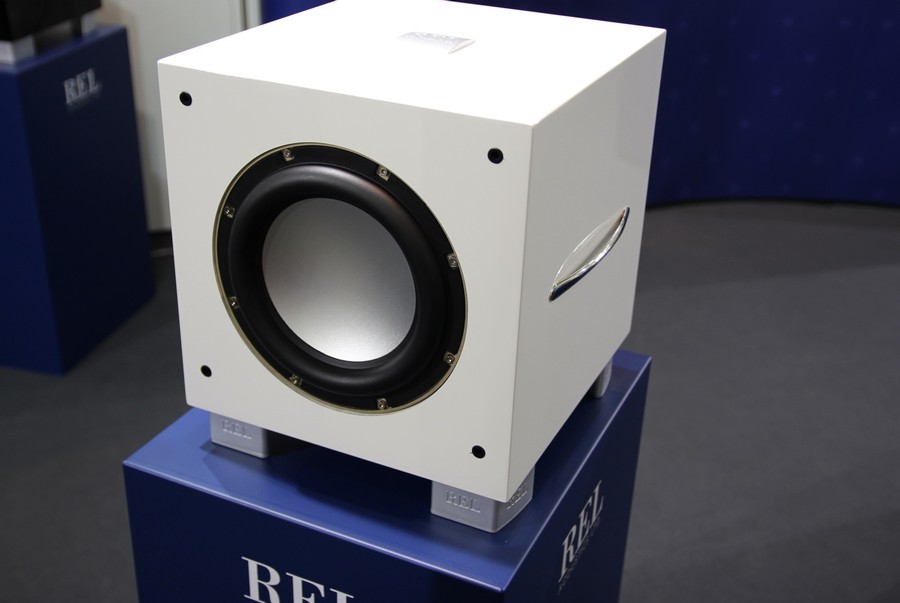
Figure 1: Subwoofer from REL
Subwoofer - Outsourcing the woofers
A human ear cannot locate low bass frequencies. It seems obvious to outsource the low bass reproduction to a dedicated bass loudspeaker - without changing the stereo image. This is called a subwoofer. The following lines deal with various types of bass generation, explicitly not only aimed at owners of subwoofers. The physics are the same.
The human ability to hear sounds is given by most textbooks with 16-16.000Hz or with 20Hz to 20.000hz. The nice thing about these two figures: They're easy to memorize and test. The problem with the specifications: the lower limit is just as easy to remember as it is wrong. Humans can perceive sounds of any depth - if they are emitted at sufficiently high levels. Whether the human listener gets the idea to use the word "hearing" at low frequencies to describe the perceived perception is, however, more than questionable. Unpleasant, sometimes even painful fluctuations in air pressure are more likely to occur at extreme low bass frequencies. The counterpart of "ultrasound" (above the hearing limit") is now the extreme low bass: infrasound (below the allegedly existing hearing limit).
The occurrence of a "flicker limit" is interesting. This limit is at a good 16Hz. Below this limit, the computing speed of the brain is sufficient to recognize the heard signal as a peridiodic fluctuation of the air pressure. You hear/feel the change of a sine wave with a pulsating up and down. It is only above the flicker limit that the classical hearing sensation comes into play.
The bass range covered by subwoofers extends from about 120 Hz (upper kick bass), over about 40 Hz (lowest side of a bass guitar) to 20 Hz (Hollywood blockbuster), in a few movies frequency analyses even show frequencies below 10 Hz. The deepest low bass on instruments is produced by large church organs. The bass columns, usually several meters high, create frequencies around 8 Hz and thus penetrate far into the infrasound range - church music with these instruments can feel like the voice of God. Even lower frequencies are found in some natural disasters, e.g. seaquakes. The production of very low frequencies at significant levels puts not only the room acoustics and the subwoofer to a hard test. Even people with a stable circulation can painfully reach their limits.
Small bookshelf loudspeakers usually have values close to 80Hz as their lower limit. To reproduce the instruments of a jazz recording, this is easily enough. The same applies to kick basses of various pop recordings. Larger floorstanding loudspeakers with considerably more volume and membrane area often undercut the 50Hz in many cases. With the right music, such as extreme synthesizer basses, this represents a significant advance.
Good active subwoofers from the middle price range (around 300€) will in most cases just manage the 30Hz under laboratory conditions in the anechoic chamber, subwoofers that produce something other than a hoarse cawing at 20Hz are already much more expensive. How the subwoofer behaves in a real living room is written on a different page - small rooms can, for example, swallow the low bass of reflex speakers completely - another undesirable effect is room modes.
If a loudspeaker fails to reproduce low frequencies, these sounds have not directly disappeared from the music. The reason for this is quite simple:
For example, a fundamental wave of 80Hz would produce harmonics of 160Hz and 240Hz. If the loudspeaker is not capable of reproducing 80Hz, the non-linear behaviour of the ear in combination with the brain's correction mechanisms can deduce the fundamental wave from the two harmonics. A manufacturer who consciously exploits this effect is Kenwood, for example, who, under the catchword "TruBass", simply omits the fundamental waves. Due to the missing low frequencies the structure-borne noise, which can significantly affect the relationship to the neighbours, is reduced. However, anyone who understands low bass to be a full body massage is likely to be rather hostile to this method.
Large wavelength - large subwoofer
When generating sound, the wavelength of the sound must always be compared with the dimensions of the subwoofer. At 3kHz the sound has a wavelength of about 13 centimetres, whereas at 20Hz it is a proud 17 metres. This has immediate effects: A tweeter capable of reproducing frequencies at 3kHz with painfully loud levels may have a maximum diaphragm excursion of 0.25mm - and this will practically never be achieved in practice. In order for a conventional bass loudspeaker to be able to deliver the same sound pressure at 20hz, it would have to have a diameter of several meters. A subwoofer with such dimensions would not fit into normal living rooms - not to mention the manufacturing costs.
This is where pragmatism comes in: Stroke instead of diaphragm area. Good woofers have a maximum excursion of several centimetres, some slightly more expensive specimens can even manage pumping movements of more than 10 centimetres. If the woofer has to have more excursion than the manufacturer had planned, the voice coil can be attached to the rear pole plate. With the raw forces acting here, this can lead to massive damage. The "banging" sounds like a shot from a small caliber weapon. Some manufacturers use foam elements to dampen the impact of the voice coil in an emergency. Alternatively, protective circuits are also used.
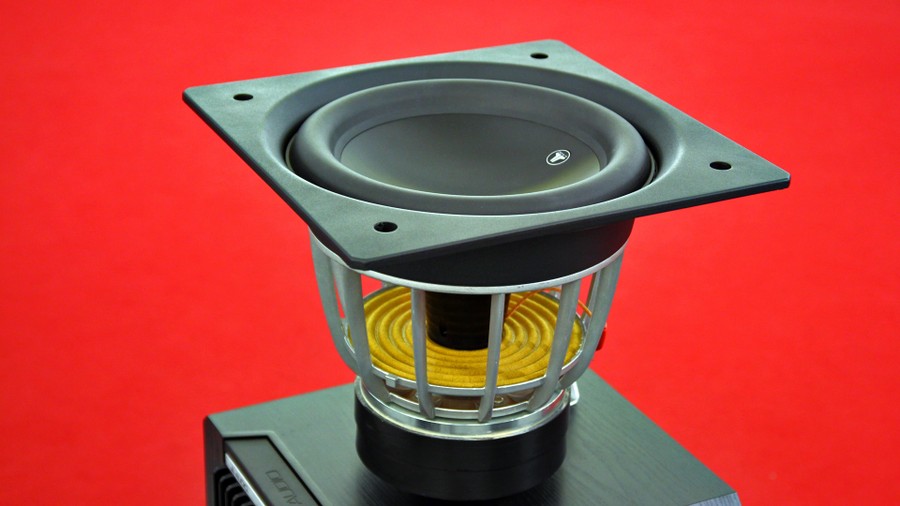
Figure 2: High-quality, high-pitched low-frequency bass chassis from JL-Audio
If you hold your hand near such a moving membrane, you will notice a strong draft when you hold your hearing close to it, but it is not louder so it is elsewhere in the room. The subwoofer acts as a omnidirectional radiator at a short distance: figuratively speaking, this means "a lot of wind for nothing". The subwoofer primarily emits reactive power, the energy is stored in the sound field in front of the speaker (near field). At the listening position you are in the far field and it is strangely windless. You can still hear the bass at a comparable volume. The pressure and the speed are now more or less the same. The explanation for this miraculous fact: the human ear is a pure pressure receiver. The virtually motionless air at the listening position doesn't disturb, nor does the stormy air movement at the bass driver. Everywhere the human ear perceives it as similarly loud.
Sound waves function as follows: Air is compressed (sound pressure). The pressure leads to acceleration until the pressure is reduced, the resulting air speed is the sound velocity. The moving air compresses the neighboring air, then the pressure maximum is reached again.
In the far-field there are periodic fluctuations of pressure and velocity which generate and cancel each other out. It hardly makes sense to distinguish between the two terms: where one is, the other will probably be.
In the near field, however, the distinction is important: a subwoofer cannot build up direct pressure in a large room with a diaphragm smaller than the wavelength. The pressure immediately escapes sideways and leads to a large sound velocity, or metaphorically speaking to the already mentioned expression "a lot of wind for nothing". In order for the subwoofer to still be able to produce high levels, it must either have a larger diaphragm or compensate for the process with more excursion. The efficiency of woofers is therefore generally worse than that of tweeters.
The tweeter is better adapted to the wavelength. Even at killer levels, the excursion is not visible to the naked eye, a draft near the membrane is not noticeable, the sound velocity is minimal, and far-field conditions prevail even at a short distance from the membrane. Nevertheless, it is capable of generating the air pressure desired by the ear without any problems.
Woofers should be large and have good excursion for high low-pass levels. But why outsource the woofer to a subwoofer? There are several applications.
Subwoofer outsourcing extreme - satellite systems
High-frequency sound can also be produced with small loudspeakers at a higher volume and bass cannot be located by humans. It is therefore obvious to distribute tiny loudspeakers in the room and to limit the bass reproduction to a single separate subwoofer.
The approach for the so-called satellite systems, or to put it less politely roaring cube systems, is based on physics. Some manufacturers have been trying to develop ever smaller satellites for years, but at least they want to offer something to design-oriented customers.
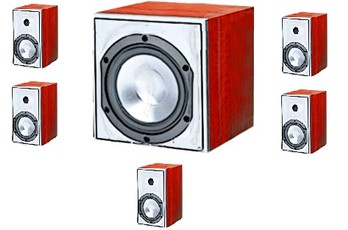
Figure 3: Satellite system
This sound generation with miniature loudspeakers is suboptimal from a technical perspective. The baffle step of the narrow baffle is in the high-frequency range - the loudspeaker radiates spherically at most frequencies and strongly excites the room and provokes a maximum of short-time reflections. The demands on free placement and acoustics are high. Due to the high baffle step in the high frequency range, the edge diffractions migrate through the small cabinets into the frequency range where the ear is most sensitive. a frequency neutral dispersion behaviour on and off axis is virtually impossible to realise.
A further problem is the reproduction of the fundamental tone: it makes sense to use subwoofers only below 100Hz, above this frequency the basses become localizable for the ear. With satellites the reproduction of frequencies below 500Hz is problematic. Either the satellites are dimensioned sufficiently large to reproduce these frequencies - or the subwoofer only fades out at higher frequencies. Especially with fist-sized miniature loudspeakers, it is almost inevitable that the second option must be chosen. The subwoofer clearly pushes itself into the stage presentation of the system due to its locatability. Inexperienced listeners usually perceive the presence of the subwoofer positively, as it seems to be a particularly potent example.
The efficiency of the satellites is usually significantly lower than that of floorstanding loudspeakers. Quickly one needs ten times the power compared to good shelf speakers, which usually need less than one watt for room volume. The coils in the roar cubes are therefore thermally much faster at the end, compression effects at dynamic peaks cannot be excluded.
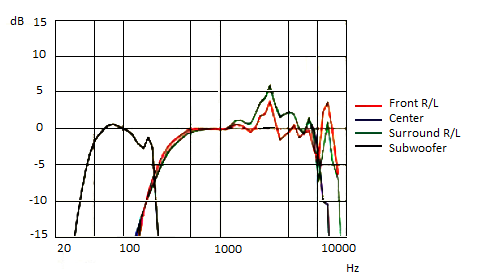
Figure 4: Frequency response of a high-priced satellite system
In the press, measurements of satellite systems are published quite rarely. Figure 3 shows the measurement of a surround satellite system of a well-known manufacturer, the price range for the system is over 1000€. The extreme resonance in the mids and the hole betwe
en the subwoofer and the satellites are a possible explanation why the system in question has always been presented with special test CDs at the dealers in my region.
I would like to dispense with the name of the manufacturer at this point.
If you are thinking about buying satellite systems, you should not be put off at this point. Some manufacturers are now building quite usable satellite systems with integrated amplifier electronics for little money. For less than 100 Euro you can buy systems which can be connected directly to a common PC, offer surround sound - and are sufficient for a child's room.
If you make a direct comparison between the smallest speakers of a satellite system and real shelf speakers, you will in many cases rather decide for the shelf speakers.
Low-frequency extension full-range speaker
Even compact speakers from affordable price ranges can now produce very good basses. So why use a subwoofer?
The use of subwoofers in high-quality stereo or surround systems with full-fledged bookshelf or floorstanding speakers is controversial among audiophiles for good reason. Subwoofers that are poorly integrated into the system are easy to locate and literally push themselves into the sound image. Also, it is almost impossible to cleanly integrate a subwoofer into a stereo system without a measuring device. Subwoofers installed by amateurs are usually 10-20dB too loud, combined with a placement close to the corner the formerly clean bass turns into a booming hum.
Well integrated subwoofers are rare - but integration is certainly possible. AV receivers with calibration functions and an intelligent placement of the subwoofer are a first step, the use of several subwoofers up to DBA systems (more about this later) can raise the bass qualitatively to a whole new level.
One reason for subwoofers is active equalization. Every loudspeaker becomes quieter and quieter from a certain lower cut-off frequency. Enclosures with large volume and reflex tubes can drive the limit down, but the limit remains. The solution to the problem: the quieter sound is compensated by amplifier power. For example, if the signal becomes 6db quieter at 35hz, the amplifier delivers 6db more at this frequency. This wooden hammer method is called "active low bass equalization" by the experts. This form of equalisation is de facto found in all good active speakers.
Unfortunately, passive speakers have become commonplace in private hi-fi systems where such equalisation is not feasible for several reasons.
Either the upper frequencies would be burned out in (water cooled??) resistors, which would significantly reduce the acoustic efficiency of the speakers in favour of the heating effect.
Another variant would be resonant circuits which supply more power at a desired frequency, but this would mean an extreme load for the amplifier output stage and an extremely bad impulse behaviour.
With active loudspeakers the solution is much simpler. The active crossover acts like an equalizer (upstream of the power amplifier) with which the frequency response has been adjusted. Active equalisation has only one disadvantage: to get the loudspeaker to high performance even in the lowest regions, very powerful power amplifiers and correspondingly resilient drivers with well cooled voice coils must be used.
The principle of active low-bass equalisation is illustrated in Figure 2.
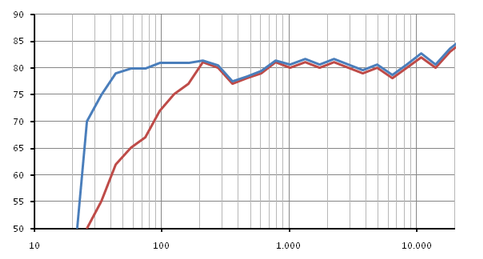
Figure 5: Conventional speaker (red) and active equalized speaker (blue)
High end bass response
Many technically experienced audiophiles consider high-quality bass reproduction without a subwoofer to be virtually impossible. Even high-quality active loudspeakers are supplemented by active subwoofers. The reason is only partly due to high demands on the maximum level - instead, it is due to the flexibility of some subwoofer concepts.
High end bass reproduction is not based on buying any expensive subwoofer and connecting it to the AV receiver at the right time. Instead, it takes advantage of the fact that subwoofers cannot be located, so they can be placed much more freely in the room to compensate for room acoustic effects. The keywords for high-end bass are for example: room calibration, dipole radiation and DBA.
More about this elsewhere.